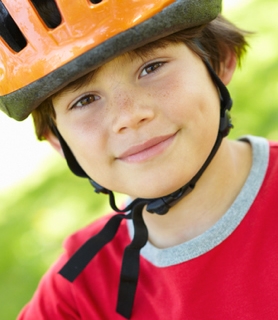Article at a Glance
- Helmets are the best way to protect our children from serious injuries like brain trauma.
- Serious accidents can even happen on short trips, so it is important to always wear a helmet.
- When shopping for a helmet, look for one that meets Snell, ANSI, or CPSC safety requirements.
Many of us grew up not wearing bicycle helmets and we turned out just fine. Are helmets really all that important? What are the chances of your child being involved in a serious accident?
The truth is that helmets have become more important because we know more. We now know that helmets are the best way to protect our children from serious injuries like brain trauma. Now that we know a helmet can mean the difference between life and death, it isn’t worth gambling with our children’s future.
As pediatricians we unfortunately see the cases of when something does go wrong. It breaks our hearts when we see that something as simple as a helmet could have made an enormous difference and saved a family from so much suffering.
The risks of not wearing a helmet
The facts on traumatic brain injuries
In 30 percent of all injury-related deaths in the US, traumatic brain injuries are a contributing factor.
But even when traumatic brain injuries aren’t fatal, survivors often have to live the rest of their lives with serious disabilities. Traumatic brain injuries can result in problems like loss of hearing, sight, tactile sensation, strength, balance, coordination, memory, and language skills. Survivors can also struggle with things like depression, headaches, an inability to concentrate, impaired judgment, impulsivity, mood swings, emotional instability, and changes in personality. Often survivors lose the ability to do things they were once proud of, things that defined them. In many ways they lose a piece of themselves.
Even in the best-case scenarios when there isn’t a traumatic brain injury, helmets can also protect children from things like scars and injuries to the face. While injuries like these aren’t as serious, they can still be difficult for children who are going through the social and identity struggles of adolescence.
For parents, the hardest part is wondering, “What would my child’s life be like if I had just made him wear a helmet?” No parent should ever have to struggle with that kind of guilt over something as simple as a helmet.
When the consequences are so serious, the cost and nuisance of wearing a helmet is such an easy way to protect our children. Unfortunately only 48 percent of children between 5 and 14 years old wear helmets when riding a bike. It is time to change that statistic.
Helmet wearing tips
- Serious accidents can even happen on short trips. So it is important to make it a habit to always wear your helmet when riding a bike, scooter, skateboard, or skates. Just one fall can change your child’s life forever.
- When shopping for a helmet, look for one that meets Snell, ANSI, or CPSC safety requirements. It should fit snugly—you shouldn’t be able to twist or pull it off. The straps should be adjustable so that they can be tightened under the chin. And make sure you always fasten the straps. If the helmet falls off, it isn’t going to help in an accident. Learn more by taking the SafeKids helmet fit test.
- Helmets can lose their ability to absorb a shock if they take a major hit. Replace your helmet immediately if you ever have a bike crash and your helmet is hit hard. Don’t allow your children to drop, kick, or throw their helmets around.
- Some children do not want to wear a helmet. It might help if you let them pick out a design they like. Also, insist that if they don’t wear a helmet, they don’t ride their bike. Most children will back down if they realize that wearing a helmet is the only way they will ever get on a bike. The right example can also work wonders. Find some videos or photos of famous cyclists or skateboarders wearing helmets. And make sure you are a good example too by wearing a helmet every time you ride.
- Even skilled bicyclists get into crashes. If your child promises to be careful or is a skilled bicyclist, a helmet still isn’t optional. Often crashes are caused by other cars, bikes, or pedestrians and aren’t the fault of the cyclist.
- Once somebody suffers from a brain injury, their coordination and inhibitions are affected and it is more likely for them to get hurt again. Do not allow your child to ride a bike after a head injury until you get clearance from your pediatrician.
- If you can’t afford a helmet, there are some organizations in Utah who want to help. For example Bikes For Kids For Utah provides free bikes and helmets to children who can’t afford them. The law firm Robert J. DeBry has a helmet safety program that makes bike helmets available to children at a low cost.
Share this article:
